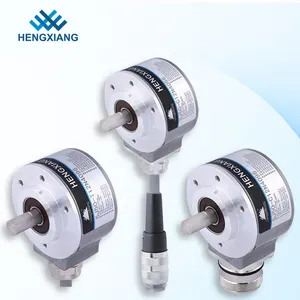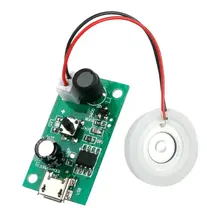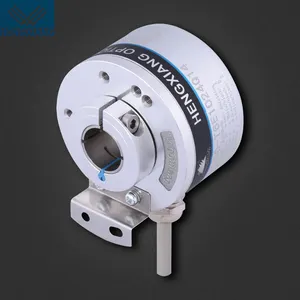What is Rotary Encoder Cost Guide
Rotary encoders are precision electro-mechanical devices commonly used for measuring the angular position of a rotating shaft or object. They are essential components in various industrial automation systems, where they ensure accurate and reliable control of machinery, robotics, and other mechanical processes. The primary function of a rotary encoder is to convert the angular motion into an electrical signal that can be read by a controller or used for feedback purposes.
The cost of a rotary encoder can vary widely depending on its specifications, accuracy, and complexity. For instance, encoders used in high-precision applications such as machine tools or aerospace may be more costly due to the fine engineering required for precise measurement. In contrast, simpler encoders used in consumer electronics or low-precision industrial applications may be more affordable.
The working principle of a rotary encoder involves a rotating disc or shaft connected to an internal optical or magnetic sensor. As the shaft moves, it causes the sensor to detect changes in position with respect to a fixed point. This change is then translated into an electrical signal that can be measured and utilized by other components within the system.
Rotary Encoder Cost Guide
Rotary encoders come in various types, each with unique features suited to different applications. Here is an overview of some common types:
-
Absolute Rotary Encoders provide information about the shaft's absolute position relative to a set point. They are often used where it's critical to maintain accuracy and resolution over an extended period without power supply. Additionally, these encoders are resistant to electrical noise and can detect and transmit the exact position of the shaft to the controller.
-
Incremental Rotary Encoders generate a set number of pulse signals per revolution. These are simpler and more cost-effective than absolute encoders but do not provide information about the shaft's absolute position. They are typically used for applications where the controller needs to know only the direction and distance traveled from a starting point.
-
Optical Encoders use a light beam to detect changes in position. They are known for their high resolution and are commonly employed in precision applications such as robotics and medical devices. Due to their speed and accuracy, they are also found in consumer electronics like computer mice and keyboards.
-
Magnetic Encoders feature a series of magnets and sensors to detect changes in magnetic fields. They offer high resolution and robustness against environmental factors like dust and moisture, making them suitable for harsh industrial environments.
-
Heavy Duty Encoders are engineered to withstand rigorous conditions such as extreme temperature ranges and high shock or vibration levels. These encoders are vital in sectors like heavy equipment manufacturing and aerospace where standard encoders would not survive.
How to choose Rotary Encoder Cost Guide
Choosing the right rotary encoder for your business involves considering several factors:
-
Resolution: The higher the resolution, the more precise the measurements. For tasks requiring fine control, such as in robotics or medical devices, high-resolution encoders are essential.
-
Environmental Conditions: The operating environment will influence your choice. Standard encoders may suffice for office or indoor applications, but harsher conditions like those in industrial settings with dust, moisture, or temperature extremes will necessitate robust construction and materials.
-
Output Type: Consider what type of signal your system can best interface with. Common outputs include analog, absolute, or incremental signals which determine how the encoder communicates its readings back to the control system.
-
Shaft Size and Fit: Ensure you select an encoder that fits your machinery's specifications in terms of size and mounting type (e.g., 6mm shaft, 8mm shaft).
By assessing these factors in conjunction with the types of rotary encoders available, you can make an informed decision that aligns with your business's operational needs.
About Rotary Encoder Cost Guide on Alibaba.com
Alibaba.com stands as a global marketplace connecting businesses with a vast selection of rotary encoders suitable for any application—from sophisticated industrial machinery to precision laboratory equipment. With its extensive network of suppliers offering products across nearly 5,900 categories including automation parts like rotary encoders, Alibaba.com makes it easy for businesses to find exactly what they need while benefiting from competitive wholesale pricing.
The platform's commitment to facilitating seamless transactions is evident through services like Trade Assurance which safeguards payments until delivery is confirmed. Its user-friendly interface allows buyers to communicate easily with suppliers and negotiate terms that meet their specific requirements including customization of products when needed.
For businesses looking to source high-quality rotary encoders efficiently while minimizing risk, Alibaba.com offers a reliable solution with its vast product listings across global suppliers. Whether it's for upgrading existing equipment or integrating into new systems, Alibaba.com provides an accessible pathway that empowers businesses to enhance their operations with precision and efficiency.
Common FAQs for Rotary Encoder Cost Guide
What is a rotary encoder and how does it work?
A rotary encoder is an electromechanical device that converts angular position into a digital or binary signal. It typically consists of a rotating disc (or wheel) with evenly spaced slots, each representing a different binary bit and an LED or infrared emitter that senses the slot position.
How do I determine the correct resolution for a rotary encoder?
The resolution of a rotary encoder is determined by the number of slots on the encoder disc or wheel that are used to create a digital output. Higher resolution encoders provide more precise position information but may also be more costly.
Can rotary encoders be used for bidirectional motion control systems?
Yes, many rotary encoders support bidirectional motion control by providing signals that indicate both the direction and magnitude of movement.
What are the different types of rotary encoders available?
There are several types of rotary encoders including optical encoders, magnetic encoders, capacitive encoders, and resistive encoders, each with specific features suited for different applications.
What should I consider when choosing a rotary encoder for an outdoor or harsh environment?
For outdoor or harsh environments, look for rotary encoders with robust construction materials like stainless steel or those that offer dust and water resistance to ensure longevity and reliable performance.
Are there any special features I should look for in a rotary encoder for industrial machinery?
For industrial machinery, consider features such as high pulse per revolution (PPR), rugged construction, and resistance to vibrations or shocks. These can ensure that the encoder maintains accurate readings despite the operating conditions.
How do I select a rotary encoder for a space-constrained application?
For space-constrained applications, select an encoder with a compact design such as a magnetic or optical encoder that can fit within the system's constraints while still providing the necessary functionality.
What materials are typically used in the construction of rotary encoders?
Materials commonly used in the construction of rotary encoders include stainless steel, aluminium alloys, plastic, and sometimes precious metals for specific applications that require durability or conductivity.
Can rotary encoders be customized for specific applications?
Yes, many suppliers offer customizable options for rotary encoders, allowing you to specify certain parameters such as resolution, material, interface type, and additional functionalities to meet the specific requirements of your application.
What does 'pulse per revolution' mean in the context of rotary encoders?
Pulse per revolution refers to the number of output pulses generated by the encoder per revolution (PPR). This value is used in conjunction with the resolution of the encoder to calculate position and velocity.
How do I know if a rotary encoder is suitable for use in a high-speed application?
Optical rotary encoders are often suitable for high-speed applications due to their ability to provide fast and accurate position measurements. Check the specifications for speed ratings (such as revolutions per minute or RPM) to ensure suitability.
What industries commonly use rotary encoders?
Rotary encoders are widely used in industries such as manufacturing (particularly in CNC machinery), aerospace, automotive, metalworking, and any industry that involves precise control over angular positioning or monitoring.









































 浙公网安备 33010002000092号
浙公网安备 33010002000092号 浙B2-20120091-4
浙B2-20120091-4